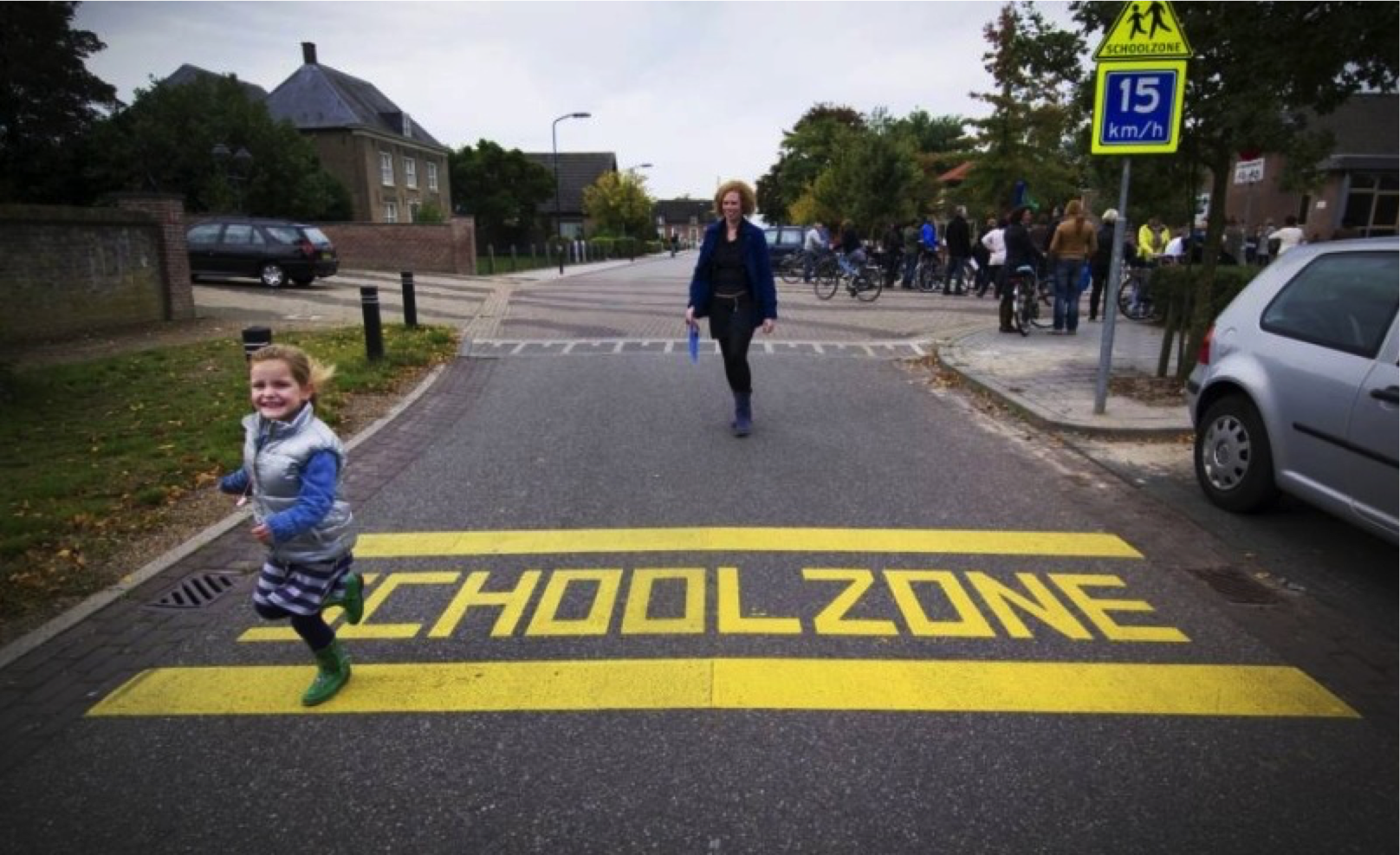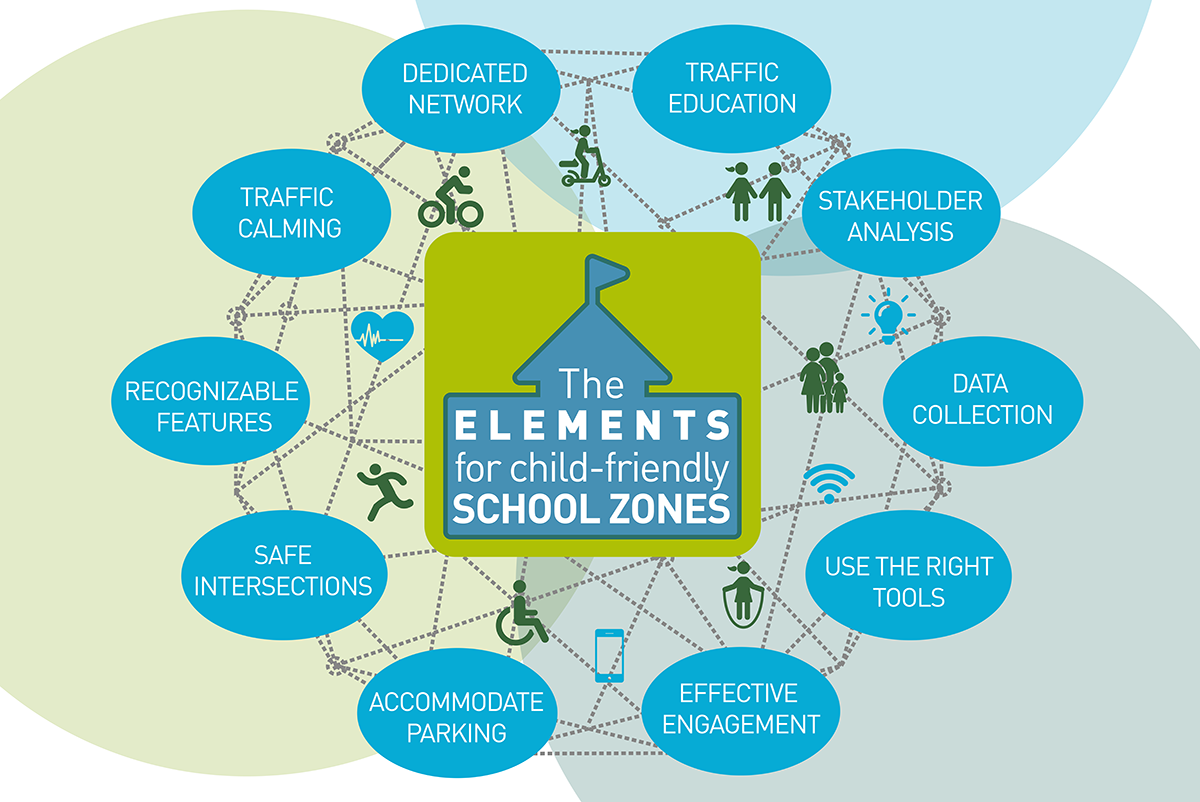Children / Cycling Education / Cycling infrastructure / Education / Pedestrians / The Netherlands / Traffic safety / Walking
Accommodating safe, independent and active travel: 10 elements for child friendly school zones
It is recommended that all children ages 5 to 17 are physically active for at least 60 minutes a day (WHO, 2011). This recommendation applies to all children and young people irrespective of gender, race, ethnicity or income level. Worldwide, around 80% of school children do not meet the recommended guidelines (WHO, 2019). However, within the Netherlands children generally meet the recommendation of at least 60 minutes of physical activity per day. This can, in part, be linked to the high rates of walking and cycling towards school. We are convinced that both within and outside the Netherlands the short journey to and from school provides the ideal opportunity for daily physical activity.

Increasingly, active travel is being recognized as an effective means of increasing physical activity and thereby contributing to people’s overall physical fitness. Travelling by foot, bicycle, scooter or other active and often playful ways perfectly enable healthy options, and we are embracing this growing acknowledgement of these active travel benefits. And it’s not just physical activity: there are multiple additional benefits to travelling in active ways from a young age. They enable children to travel independently, stimulating their self-confidence, spark a feeling of joy, contribute to reducing carbon footprints, and reduce air pollution and congestion.

In the 1970’s, following the Stop de Kindermoord protests along with other movements throughout the country, the approach to traffic planning and policy in the Netherlands began to shift. Rather than focusing solely on the efficient movement of cars, policies like Sustainable Safety emphasized the importance of creating safe environments for all road users, especially the most vulnerable. As a result, the rates of children walking and cycling to school have been allowed to flourish, enabling that freedom of movement, and positively impacting the lives of both children and their parents.
Mobycon is eager to share our (Dutch) expertise gained through years of working to accommodate safe and active travel. We want to contribute to the benefits that result from enabling walking and cycling to school. To help we’ve compiled a number of elements and best practices that facilitate this, specifically focusing on our young generations. Accommodating safe and active travel within school zones is truly a worthwhile long-term investment.
Active travel within school zones, what does the trick?
In many communities, the design of the street means pedestrians and cyclists often do not enjoy the same physical protection as those travelling by car. This leads to unsafe conditions for people walking and cycling, as well as children playing in the streets, and increases the potential for serious injuries or death. As a result, safe streets are vital for vulnerable groups, in particular children. Appropriate behaviour is imperative for all groups in order that, not matter the age or ability, using the transportation network by active means can be done safely.
School zone elements
We propose 10 guiding elements to accommodate safe active travel within school zones. While the elements are divided within three themes, Engineering and Education and Engagement, the elements are not meant to be applied in isolation. Combining all elements is essential.
 Engineering
Engineering
Traffic calming: Design the street–and network–to dictate people’s behaviour. Creating an environment that forces people to slow down and be aware of fellow road users makes the street safer for all users. For more details of traffic calming see Good speed by design: A network approach to traffic calming
Recognisable features: Road users should be instantly aware when they are in the vicinity of a school. This can be achieved in a number of ways, through street treatments, signage and street markings, all of which tell people to expect children in the space and to act accordingly.
Safe intersections: Often the most dangerous but also overlooked aspect of a network, most children will have to navigate a crossing at some stage of their trip to school. Designing intersections that prioritize and protect pedestrians and cyclists ensure safer environments for even young travellers. (See Destressing Intersections by Design)
Accommodate parking: In school zones, accommodating at least three different forms of parking impacts the quality of the space. This includes: car parking, bicycle parking and pedestrian ‘parking’.
Dedicated network for cycling and walking: A safe school environment is only as successful as the network connected to it. It is imperative to consider how the streets connecting to a school zone encourage walking and cycling to make the journey from the front door at home to the school comfortable for everyone.
Education
Permanent traffic education & the active involvement of parents: Encouraging children to walk or cycle to school extends beyond just the design of the streets. Through in-school traffic education children learn how to behave in traffic, preparing them to make the trip on their own. At the same time, parents provide lifelong learning that starts before children enter their first years of school and carry on long after.
Engagement
Stakeholder analysis: Creating and encouraging safe and active school travel habits requires a team effort from all stakeholders. Bringing everyone who is responsible for children’s safety to the table increases the potential for success in programming.
Use the right tools: The success of establishing active school travel habits and safe school zones depends of incorporating the best interventions and monitoring user experience, programme results and shifts in travel behaviour.
Data collection: It is important to understand how the school community currently travels and why. From this, actions and programming can be created that consider current challenges, and establish tools for measuring change over time to monitor programme success.
Effective Engagement: Often one of the biggest pitfalls when introducing new initiatives is misinformation or lack of communication. Clear and open communication of your goals, presented in an engaging way, help people understand what you are trying to achieve and why it is important.
Sharing best-practice for global success
Creating safe school zones that enable children to independently walk and cycle to school is a truly worthwhile, long-term investment. For this reason, we are excited to invite you to our next webinar: The elements for creating child friendly school zones, Tuesday, the 9th of June at 19:00 (Amsterdam). Mobility advisors Shelley Bontje and Sophie Simon are eager to share our expertise, incorporate the discussed elements in practical situations and provide advice how to get started. We are looking forward to your questions and contributing to safe and active school zones across borders.



